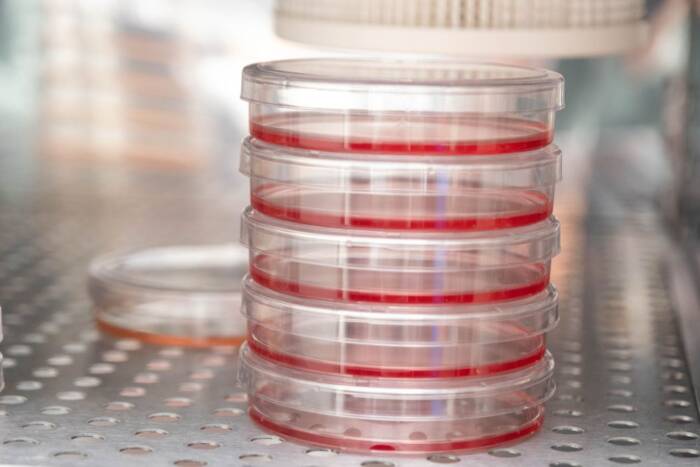Circadian Rhythm Set by Pairing of Two Proteins
The molecular control of the daily cycle known as circadian rhythm lies in the pairing of two proteins, scientists report in a trio of papers in the Nov. 3 Science. The findings, from fruit fly studies, promise to help scientists better understand human, animal and plant circadian rhythms, which influence cell and body biochemistry, health, aging and behavior.
“Our data show the setting and running of the daily body clock comes from thedelicate affinity of two proteins,” says senior investigator Michael W. Young,Ph.D., professor and director of the Laboratory of Genetics at The RockefellerUniversity and an investigator at the Howard Hughes Medical Institute(opens in new window)(HHMI).Young also directs the National Science Foundation (NSF) Science and TechnologyCenter for Biological Timing at Rockefeller. NSF supported the studies.
Like people, fruit flies have daily rhythms lasting approximately 24 hours.In 1971, scientists at the California Institute of Technology discovered a flygene, dubbed period (per), involved in the clock, but exactly howit worked was unknown. In 1984, Young and his collaborators at Rockefeller anda second group of scientists at Brandeis University led by HHMI investigator Michael Rosbash, Ph.D., and Jeffrey Hall, Ph.D., cloned the per gene andcharacterized the protein it makes. In 1994, Young’s group identified a second clock gene, timeless (tim).
 In the new studies, Young and collaborators from Rockefeller, the Universityof Pennsylvania and Harvard Medical School cloned the tim gene,determined the order of nucleic acids in its DNA structure and characterizedthe protein it makes, TIM. By investigating what happens when tim andper are damaged in mutated flies, the researchers also established howthe TIM and PER proteins together set the body clock.
In the new studies, Young and collaborators from Rockefeller, the Universityof Pennsylvania and Harvard Medical School cloned the tim gene,determined the order of nucleic acids in its DNA structure and characterizedthe protein it makes, TIM. By investigating what happens when tim andper are damaged in mutated flies, the researchers also established howthe TIM and PER proteins together set the body clock.
“The tim and per genes, through the proteins they make, have atrue partnership in operating the body’s clock,” says Young. “We found thatpart of the TIM protein binds to the PER protein. Once joined, the proteinsenter the cell nucleus, a process that sets the time and duration of thecircadian cycle.”
All cells in the fly have per and tim genes, but the cells inthe fly’s brain set the body’s clock. “The two genes become active at midday,”explains collaborator Amita Sehgal, Ph.D., of the Department of Neuroscienceand Center for Sleep and Respiratory Neurobiology at the University ofPennsylvania School of Medicine. “In the cell’s nucleus, the genes’ DNA codeis transcribed into two RNA molecules, per RNA and tim RNA, whichaccumulate over several hours in the cell.”
At dusk, the levels of RNAs peak and only then does the cell use the RNAs tostockpile PER and TIM proteins. In the evening, the proteins join and crossinto the cell’s nucleus. About four hours before dawn, the PER and,presumably, TIM proteins in the nucleus reach their maximum amounts, anachievement that signals the per and tim genes to stop making theRNA. Near dawn, the nuclear proteins begin disintegrating, the cycle beginsagain and throughout the daylight hours the per and tim genesproduce new RNA to make replacement proteins.
The pace of the clock appears to stem from the gradual, coordinatedaccumulation of the tim and perRNAs during several hours, aswell as from the attraction of the PER and TIM proteins for each other, Youngreports.
“The PER and TIM proteins have an affinity for each other, but it is not astrong link,” Young says. “Only if the two proteins are available insufficient quantities do they begin to bind. Most importantly, the proteins canonly survive and enter the cell nucleus when they are bound to each other.Therefore, about six to eight hours lapse between the time of peak RNAaccumulation, which occurs around dusk, and the peak in the nuclear proteinlevels, shortly before dawn.”
This pattern of late binding of the proteins sets up daily cycles of RNA andprotein production, because only after the bound proteins enter the cellnucleus can they turn off further synthesis of RNA from theper andtim genes. Further evidence of the power of the binding pattern comesfrom studies of mutant fruit flies who have 29-hour body clocks that slow evenfurther when their temperature rises. Young and his colleagues found thatthese flies have a mutated form of the PER protein that binds improperly to theTIM protein. The two proteins bind more poorly as temperatures rise,consequently delaying the PER protein’s entry into the nucleus and slowing theclock.
Additional mechanisms and other, as yet unidentified, proteins also mayinfluence the interaction between the PER and TIM proteins, which could affectthe timing, Young adds. For example, scientists know that light affectscircadian rhythms, and, Young notes, evidence exists that the PER/TIM proteinunion is affected by light. This sensitivity may help explain how body clocksare reset after a period of jet lag that occurs as a traveler crosses timezones.
In addition, the scientists are searching for the genes of the human bodyclock. “In general, the genes that control fundamental body mechanisms arepassed on in evolution,” Young explains. “Now that we know the mechanisms inthe fly’s body clock that produce the TIM and PER proteins, and the feedbackloops involved, we expect to find a similar process in the body clocks ofhumans.”
In humans, daily circadian rhythms underlie many functions, including thesleep/wake cycle, body temperature, mental alertness, pain sensitivity andhormone production. In natural conditions, many rhythms have a 24-hour periodrelated to sunlight, but though light can affect the rhythm, it does not causethe cycle. In fact, in the absence of light or other environmental clues,rhythms continue and most adapt to periods slightly longer or shorter than 24hours, Young notes.
During the fly study, the team measured for four days the levels of RNA in theabsence of light. Both timand per RNA accumulated at the samepace, peaking together once every 23 hours. On some days, the peak amount ofRNA could be as much as 15 times greater than the lowest level.
Young’s coauthors on the first paper, Positional Cloning and SequenceAnalysis of the Drosophila Clock gene, timeless, are Michael P.Myers, Ph.D., Karen Wagner-Smith, M. Phil., and Cedric S. Wesley, Ph.D., ofRockefeller and HHMI, and Sehgal of the University of Pennsylvania.
Young’s collaborators on the second paper, Rhythmic Expression oftimeless: A Basis for Promoting Circadian Cycles in period GeneAutoregulation, are Adrian Rothenfluh-Hilfiker and Myers of Rockefeller andHHMI, and Melissa Hunter-Ensor, Yifeng Chen and Sehgal of the University ofPennsylvania.
Young’s coinvestigators on the third paper, Isolation of timelessby PER Protein Interaction: Defective Interaction Between timelessProtein and Long-Period Mutant PERL , are Lino Saez, Ph.D., andMyers of Rockefeller and HHMI; Sehgal of the University of Pennsylvania; andNicholas Gekakis, Ph.D., Anne-Marie Delahaye-Brown and Charles J. Weitz, M.D.,Ph.D., of the Department of Neurobiology at Harvard Medical School.


